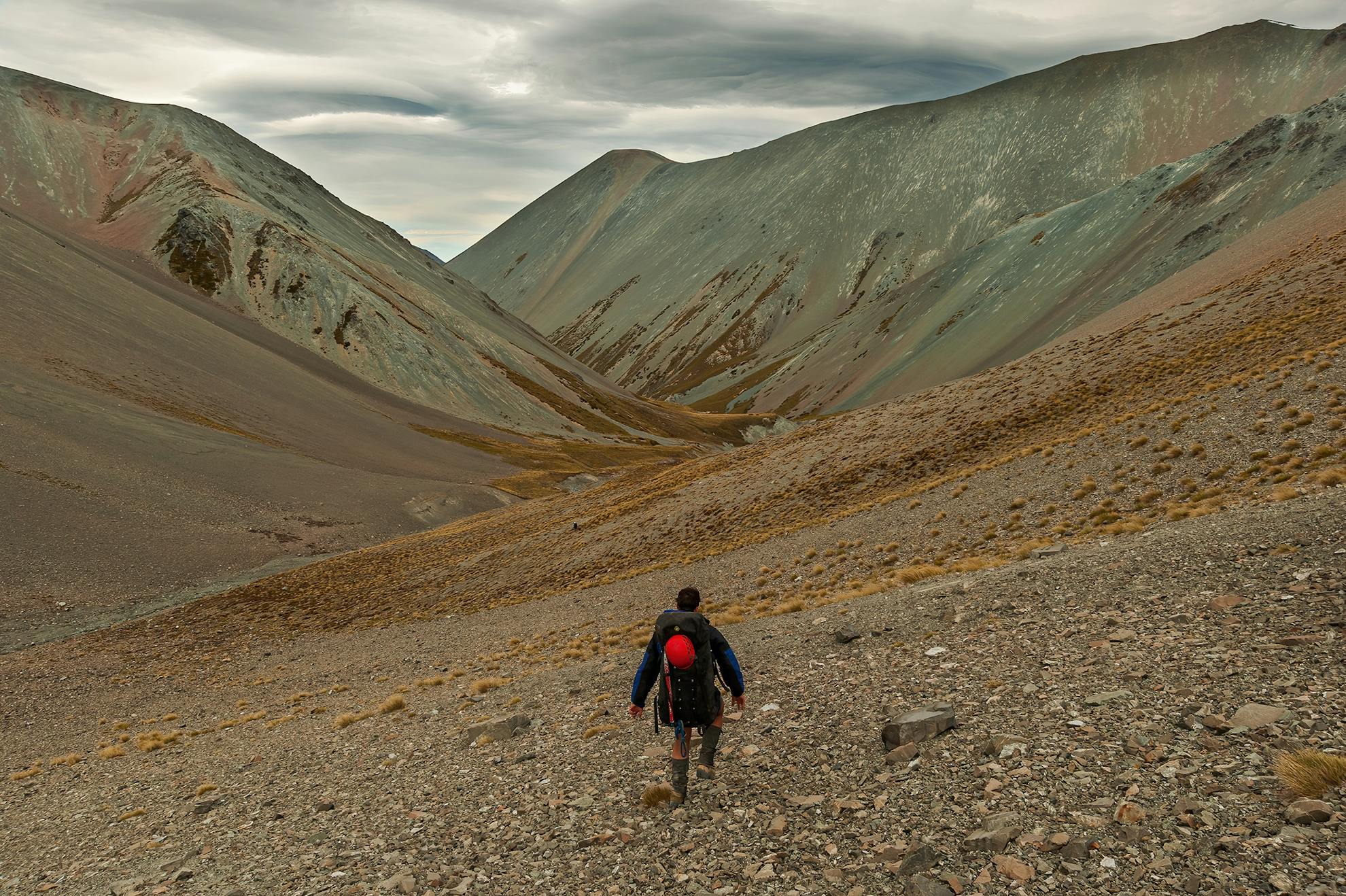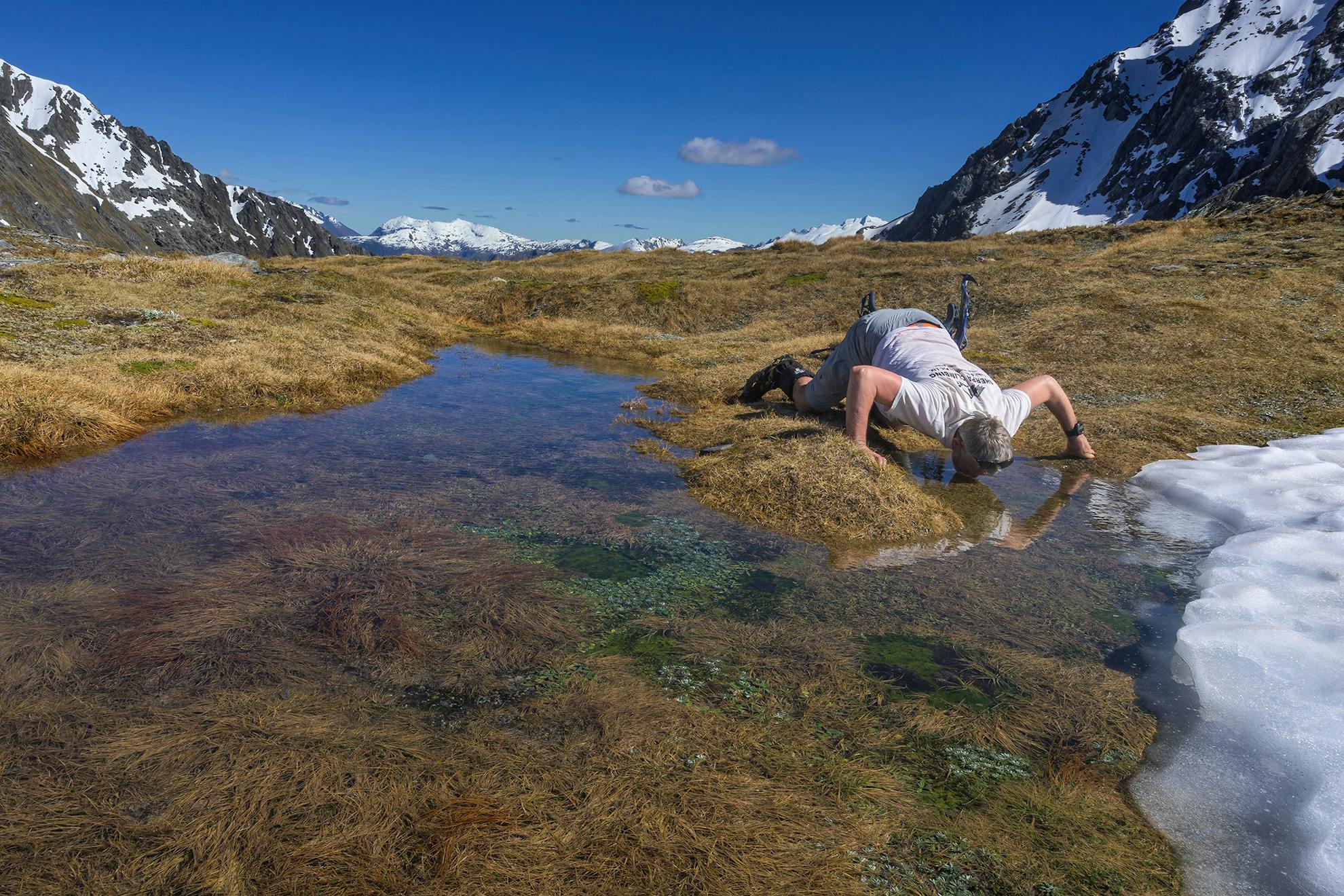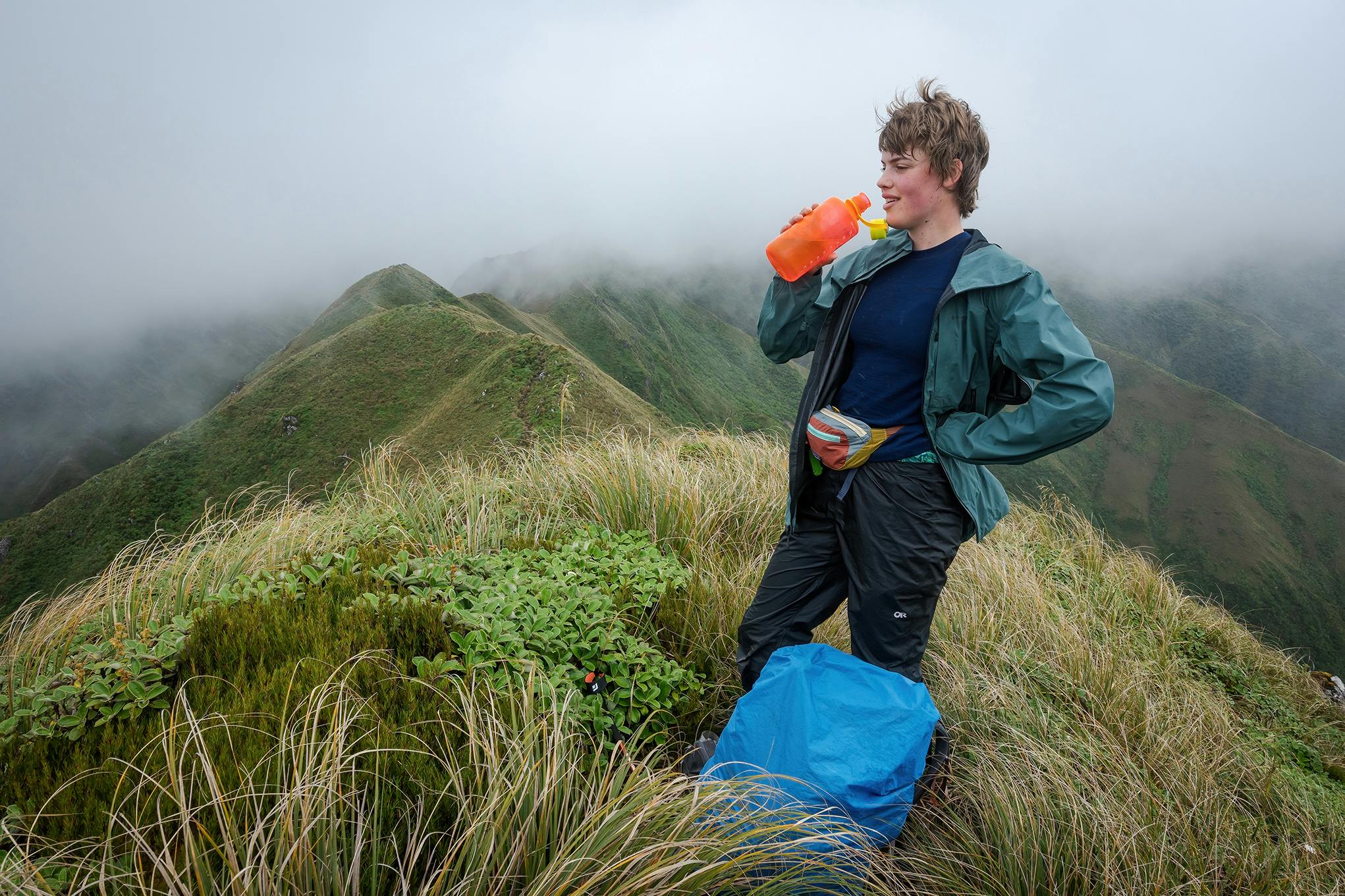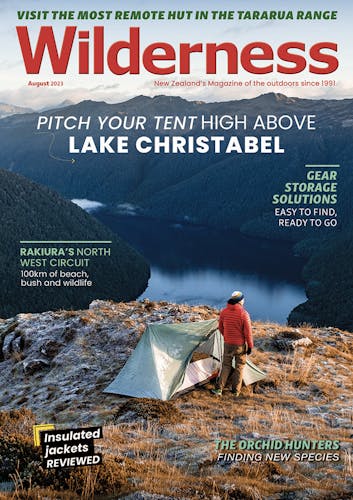Drinking enough water is crucial to your performance in the outdoors. But how much and how often – and how have attitudes to hydration changed?
Wellington’s Te Kopahou Reserve is a place of steep hills, scrubby coastal headlands and numerous tracks. A few years ago I ran from my home, around the south coast, grinding up the 400m Tip Track climb almost to the observatory at Hawkins Hill, then down to Red Rocks and along the coast back home. Twenty kilometres, in the heat of the day, at a jog. Door to door, nearly three hours. I was shattered. And for the rest of the weekend, near useless.
I was training for a run over the Tararua Range’s 32km Southern Crossing. Despite jodphur-shaped thighs, I’ve never been a fast runner, and the race would probably take me eight hours.
So how do people train for long mountain runs? I consulted Lucky Legs, multisport legend Steve Gurney’s autobiography. During my three-hour run, I’d eaten no food. But more importantly, I’d not drunk enough water. Gurney recommended as much as one litre per hour.
The next weekend I took a 2.5-litre bladder of water and energy gels. It was difficult to drink that much water. Sipping while also trying to breathe on the punishingly steep Tip Track was more than my lungs could cope with. Instead, I drank whenever humanly possible: on the flat and downhill sections. And gagged down two sickly sweet gels. Got home slightly faster, but that was not the point.
After resting for a couple of hours, I felt fine. Good, even. Soon my energy returned and I could be a useful parent. Proper hydration, plus two gels, proved transformational. Thanks Steve.
Mountain running, unsurprisingly, requires excellent hydration. But what about tramping or climbing? How much does water, or lack of it, affect performance? Could drinking too little mean more than just becoming thirsty: could it be dangerous?
I thought back to a Mt Owen trip when my friend Darryn and I traversed the marble mountain. From the Owen River we’d tramped with full packs to Sunrise Peak, a steep climb of some 1100m, then sidled around the fissured limestone slopes of the mountain’s southern side. Although we’d drunk a litre of water at the river and carried a litre more, the blistering heat of February meant we soon ran out. Summer had parched the mountain. We found no tarns, not even a trickle. Despite the craggy magnificence of the tors, we both felt unnaturally fatigued, our blood thick. We grew increasingly tired and slow.
According to Ministry for Health advice on hydration, just a two per cent rise in blood thickness can make you feel thirsty. A five per cent increase means dehydration. We were at that level.

Tarns, hundreds of metres below in Castle Basin, lay tantalisingly out of reach. Exhausted beyond what we would normally experience, we finally reached water in Poverty Basin and lapped it like dogs. Darryn couldn’t eat dinner that night, and vomited. I ate little and didn’t feel well either. Dehydration had sapped even the energy required to digest food. Even two per cent dehydration may make you feel nauseous. In these circumstances, it pays to rehydrate slowly.
Hydration is now underpinned by modern science. The government’s Health Navigator website states that our bodies comprise about 50–80 per cent water, depending on age and body weight. ‘Water is involved in many processes in our body, including digestion, absorption, transportation, dissolving nutrients, temperature regulation and getting rid of waste products,’ it says.
So staying hydrated is key to most bodily functions, and dehydration will result in a lowering of your aerobic ability when in the mountains.
In the past, how much to drink has been a matter of some contention, especially in the mountains. When gathering material for my tramping anthology Across the Pass, I was bemused to discover this account from Geoffrey Orbell’s book Comfort and Common Sense in the Bush (1952): ‘The test of the fit tramper is whether he feels the need to drink at every stream he comes to. If you find yourself wanting to drink, restrain the impulse. Restrain it with all your willpower, for if you don’t do so you will rapidly crack up, and be a burden to the rest of the party.’
Common sense? Hardly. Orbell’s advice seemed cracked. Yet he was a respected outdoorsman, founder of the New Zealand Deerstalkers’ Association and world-famous for his 1948 rediscovery of takahē in Fiordland. Furthermore, he was a doctor. How could he have got it so wrong?
Orbell wasn’t the only well-known figure to eschew drinking. Mountain guide Harry Ayres, who famously mentored Ed Hillary, was also a proponent of minimal drinking on a climb.
Where did this warped thinking come from?
Mountaineering historian Graham Langton says the idea probably came through British mountain-craft manuals. During the first half of the twentieth century, when Ayres learnt his craft, New Zealanders consulted British instruction books – as there was nothing available here. And British mountaineers took their lead from guides in the European Alps, who usually drank wine rather than water. Manuals often hinted at the dangers of drinking water, or voiced suspicion that drinking cold water during exercise could be harmful. Sometimes the water quality itself was in question. For example, in Mountaineering (1893) Claude Wilson wrote: ‘I am sure that it is well to drink nothing between meals, at any rate while going up. A man who drinks at every stream he comes to is always thirsty, but this habit of constant thirst can be cured by the exercise of a little self-control.’
Another influential book, The Complete Mountaineer (1907) by George Abraham, stated: ‘Of course the ideal would be to eschew all liquid refreshment, for the transit of such things in the Alps is a troublesome matter.’
In Mountain Craft (1920), perhaps the most influential manual of the period, Geoffrey Winthrop Young was unhelpfully equivocal: ‘Some resolute men, to avoid the delicious temptation, train themselves not to drink at all during the day; and then make it up in the evening. But a certain amount of liquid is as essential, in action, as a certain amount of food, and the moderate habit has to be acquired by practice. The exact amount necessary, as distinguished from acceptable, varies with the individual.’
These confusing ideas seemed to stem from concerns about the dubious quality of water (much more a problem in the European Alps than in New Zealand), the supposed ‘weakness’ a climber might develop by drinking too much, and the chilling effect of drinking supercooled water from a source such as ice-melt. As Langton suggests, ‘Possibly these superstitions and prejudices morphed into not drinking at all, which was common in New Zealand mountaineering, even as late as the 1960s.’ Hence Orbell and Ayres.

By then, however, science was beginning to understand the debilitating effects of dehydration, especially at altitude. Fortunately, Ed Hillary didn’t follow Ayres’ example, otherwise he wouldn’t have made the summit of Everest. Cantankerous but brilliant British physiologist Griffith Pugh played a crucial but mostly unacknowledged role in that successful 1953 Everest ascent. Pugh had examined the effects of hydration and nutrition on climbers during the previous year’s British Cho Oyo expedition. He ascertained that altitude reduced appetite, which was often made worse by dehydration. Staying hydrated high on the mountain required increasing amounts of effort, because every drop of water had to be laboriously melted.
Pugh’s answer? To ram home the importance of hydration. He advised climbers to increase their daily liquid intake from the previously recommended 1.5–2 litres to 3–4 litres. Water sweetened with sugar helped make it more appealing. He also advocated that climbers eat their favourite (therefore most palatable) foods. About 20 per cent of water intake typically comes from food.
On 28 May 1953 at camp nine, high on Everest, Tenzing and Hillary hacked a precarious shelf for the last camp before their famous climb. ‘A soft purr from inside the tent,’ Hillary wrote in High Adventure, ‘showed that Tenzing had succeeded in lighting the kerosene stove. This was good news, for we regarded ample supplies of moisture as a prime essential.’
That night Hillary ate one of his favourite foods: apricots. Not only was the tinned fruit tasty, but it contained a lot of moisture. Before setting off the next morning, the two climbers drank ‘great mugs of lemonade’. While Hillary had sometimes been disparaging of Pugh’s scientific experiments, he had absorbed the crucial lesson: stay hydrated.
Other scientists have since unravelled more about the complex nature of hydration, including the matter of salts. How our body absorbs moisture depends on the balance of salts in the bloodstream. When sweating, we lose salts that are critical to our ability to absorb enough water.
Dunedin climber Paul Hersey says he can get by with little food, but believes hydration is crucial – along with enough salts to absorb it. ‘Being a slightly bigger build,’ he says, ‘and hence a heavy sweater during prolonged exertion, I used to carry upwards of 4–5 litres for what might be a particularly hot climb, and stop at every available side stream to refill. But if I had already sweated my salts out during the walk in, all the extra water did was make me pee all the time!’ These days he uses electrolytes and around 2–3 litres of water. ‘That seems to be my sweet spot. I usually carry one Nalgene bottle and a soft bladder that rolls up easily. And, even on cold days, I still force myself to drink what I carry.’
There’s one more reason for carrying water. During a trip to Arthur’s Pass National Park with friend Steve Baker, we climbed high above Sudden Valley Biv, intending to cross a range into the Hawdon Valley. However, after avalanche danger prevented the crossing, we decided to descend a steep scree slope, initially through crags. Steve fell, then cartwheeled, banging his temple and gouging his knee to the bone. Once he had hobbled to a ledge with my assistance, I tended to his wounds and pulled out some painkillers. But we had run out of water. In shock, and nauseous, Steve had to gag down the pills dry. Ever since, I’ve tried to carry at least enough water to swallow pain medication.
It reminded me of a quip from a hut book (taken from Coleridge’s ‘The Rime of the Ancient Mariner’): ‘Water, water everywhere, and not a drop to drink.’ Not taking water for granted is certainly something to aspire to.
Basic rules of hydration in the hills
- Start drinking 2-4 hours before exertion.
- Drink regularly when on the move. Half a litre an hour is reasonable.
- Drink more when it’s hot or when sweating.
- Be guided by thirst, but also plan additional drink stops. Be aware that individuals can have markedly different water requirements. Older adults have fewer water reserves and a less-reliable sense of thirst.
- Young children dehydrate quickly and aren’t always good at regulating their water intake.
- A healthy measure of hydration is peeing 4–5 times a day. Dark yellow pee is a sign of dehydration. A pale yellow colour indicates you’re probably not getting enough fluid.
- Better to carry too much water than not enough. Water supplies cannot always be guaranteed. Over long dry summers, hut water-tanks can run dry, especially at popular huts.
- You still need to drink when it’s cold.
- It’s possible to drink too much, but usually our kidneys get rid of excess water before it’s absorbed.
- Sports drinks or electrolytes can help replace lost salts.








